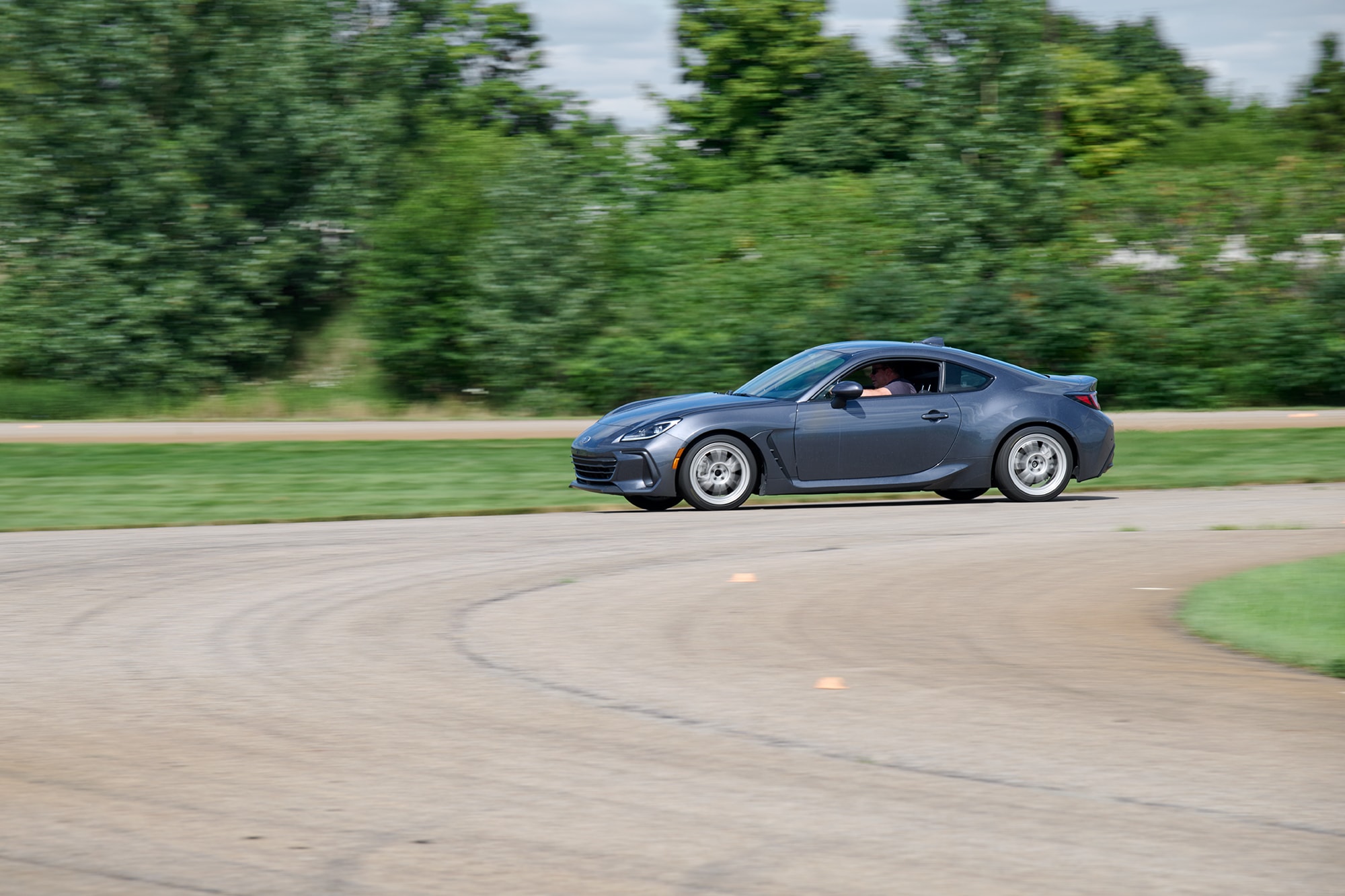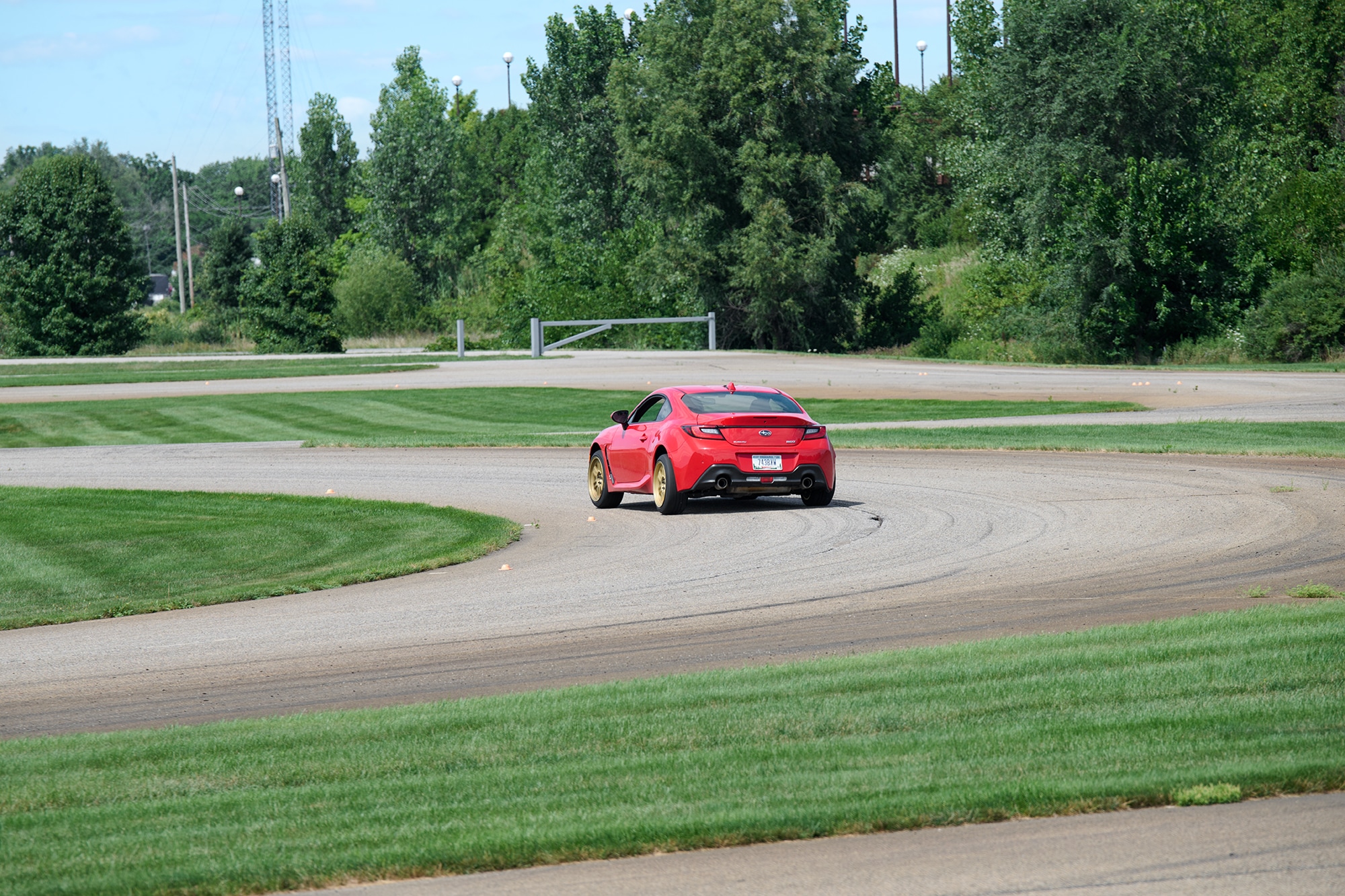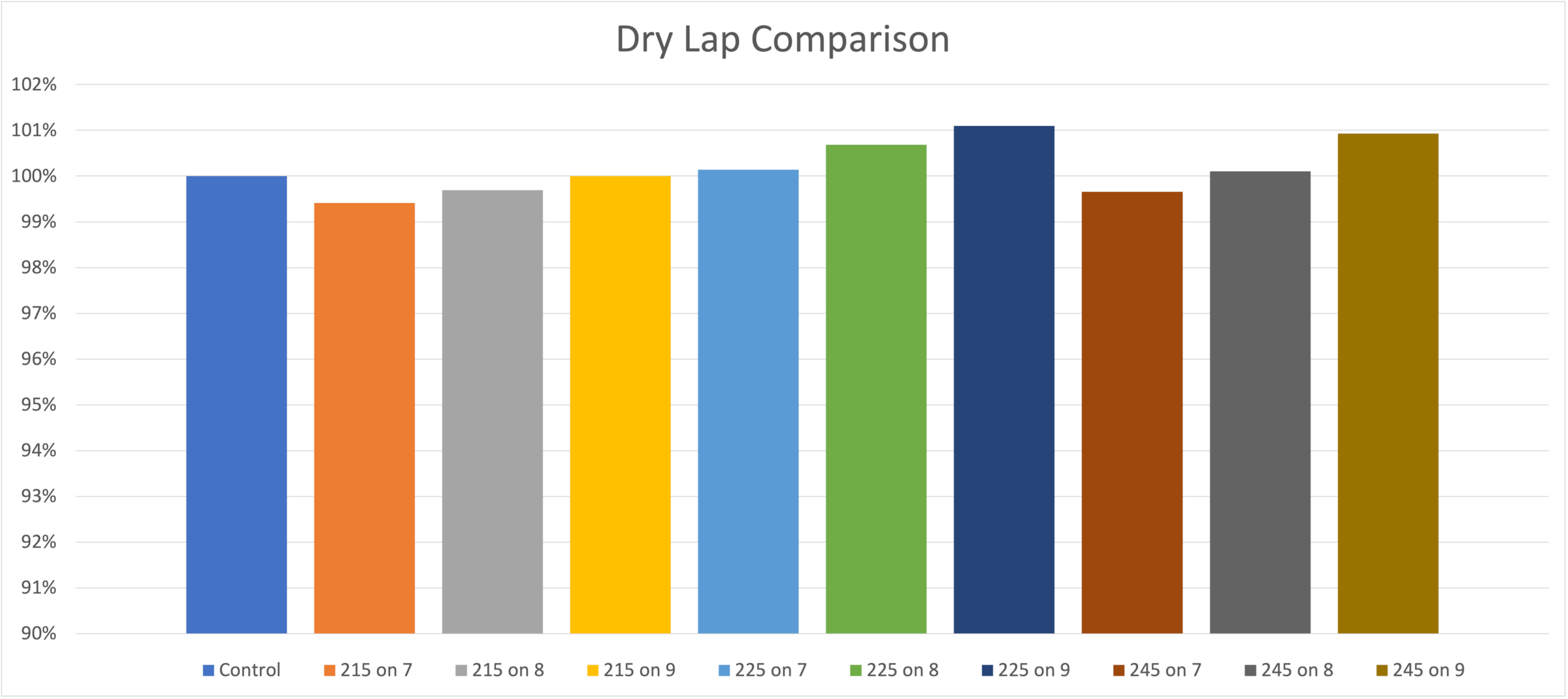There’s a long-standing automotive joke that the first race took place as soon as the second car was built. Logically, that means the first person started looking for ways to make their car faster as soon as the race was over. It’s a seemingly unavoidable reality of racing - even under the most stringent ruleset, competitors will try to exploit any and every possible advantage they can find (looking at you, Spec Anything). Outside of the world of Spec racing, where tire and wheel width are both fixed, a common practice of rule makers is to limit the maximum tire width and/or wheel width, but they typically don’t specify a minimum. This leaves some room for experimentation by competitors. Conventional wisdom, or maybe just human nature, has typically led racers to default to stuffing the widest tires that can possibly fit under the fenders, and at the Tire Rack it’s an everyday occurrence for us to mount "pinched" fitments for track use-only applications.
Even without draconian rules, racers and enthusiast drivers must make a choice. What fits? What do I have to do to make it fit? Is it readily available? And how much is it going to cost? The answers to all these questions play into the decisions ultimately made by each driver in terms of their tire and wheel package, and let’s face it, the outcome frequently comes down to fitting the widest tire, with wheel width as a secondary factor.
Is that the fastest combination, though? Some limited tests have been performed, and there’s a lot of anecdotal information surrounding what select individuals are using, but nothing definitive. We wanted to change that, so we set out to perform a Tire Rack test to generate some scientific, repeatable data to help enthusiasts make the right decision.
Fortunately for us, our trusty Subaru BRZ test vehicles can fit a relatively wide range of tire and wheel widths, and Bridgestone’s new Potenza RE-71RS was available in the perfect sizes for our test. We opted to use the 215/45R17, 225/45R17, and 245/40R17 dimensions for "narrow," "medium," and "wide" options. For test wheels, the Enkei Racing RPF1 was the obvious choice, as it comes in a variety of widths and is a very popular option for enthusiasts and racers alike. We selected 17" x 7", 17" x 8", and 17" x 9" wheels, and as icing on the cake, they’re available in several colors, so we were able to color-code our test wheels for easy identification. The 17x7s were black, the 17x8s were silver, and the 17x9s were gold. Because Subaru.
In order to test every tire size on every wheel width, we would have nine total combinations. We also wanted dry and wet test results, so it would require three full days of testing. To make sure our results were comparable between days, we ran a control tire each day so we could normalize our data across the whole test. That meant four specs each day, with four BRZs in our test fleet. Convenient.
Looking at the results from each spec, you’ll see they’re reported as a percentage. The percentage is relative to the control tire, which is set at 100%. Anything below 100% is slower than the control tire. Anything above 100% is faster than the control tire. This allows easy comparison between specs, even though they weren’t tested on the same day. You’ll notice in many cases, we’re dealing with differences of less than 1%. While that’s very close, on our track, a single percent difference equates to multiple tenths of a second on the stopwatch.
Day 1: The 215s.
215/45R17 tires on 17x7 wheels:
In the dry, this combination was easy and pleasant to drive. The rear end was never upset - it would take full throttle almost immediately at corner exit without rotating. There was just a little bit of push, leaning slightly toward understeer, but overall was mostly balanced. Our drivers wanted more steering response to deliver a more authoritative feel at the front end. It was very forgiving of mistakes and easy to handle at the limit, and our drivers walked away thinking it would probably be a great option for a new driver, but we wanted more. Average Dry Lap: 99.42%

Similar to the dry, in the wet it was very forgiving and easy to drive. Breakaway was gradual, but the turn-in was slow, and it didn’t feel incredibly athletic. Average Wet Lap: 100.76%
215/45R17 tires on 17x8 wheels:
With some additional stretch, the steering responsiveness improved noticeably in the dry. The turn-in was sharper, and the vehicle wanted to rotate more. Ultimate speed increased, though it didn’t feel as balanced as either of the other 215 combinations. Average Dry Lap: 99.69%
Wet lap times improved, and our drivers noted improved front end authority combined with more abrupt breakaway at the rear. Average Wet Lap: 101.83%

215/45R17 tires on 17x9 wheels:
For Track Use Only. Not to be Driven on Public Highways.
The steering was very quick, crisp, and direct, giving the vehicle a "slot car" feel as it navigated the track. The rear was nicely settled up to its limit, allowing easily controllable rotation that would break away abruptly if pushed too far. It was easy to catch and bring back under control, though. Average Dry Lap: 100.00%
The 215 on the 9 was the most difficult to drive combination of the day in the wet. The steering was quick and precise, with satisfying heft. The transition from grip at the front to understeer was relatively sudden, and the rear would step out somewhat easily. Ultimately it was very capable. This combination set the fastest outright wet lap of the test, but its difficult nature meant our reported average laps were a touch slower than the 215 on the 8. Average Wet Lap: 101.59%
Day 2: The 225s.
225/45R17 tires on 17x7 wheels:
Somewhat slow and lethargic steering made the 225 on the 7 the only combination on Day 2 that felt like the driver could potentially get a little "behind" in the slalom in the dry. It just didn’t have the instantaneous reaction of other combinations. The rear felt planted and stable, and the overall balance leaned toward understeer. Average Dry Lap: 100.14%
In the wet, the balance was more neutral, with just a touch of push remaining. It delivered a good combination of traits but wasn’t quite as eager or capable as the other options. Average Wet Lap: 99.42%
225/45R17 tires on 17x8 wheels:
This combination felt "right," like it’s the setup that was used during development of the tire. Turn-in was strong, and the steering was responsive and immediate. It put down the power well and would rotate in a predictable, easily controlled manner. Average Dry Lap: 100.68%

Our drivers’ comments from the wet testing closely mirrored what was found in the dry. It seemed like all attributes were proportionate and in balance. Breakaway was gradual, and it was mostly forgiving at the limit. Average Wet Lap: 100.25%
225/45R17 tires on 17x9 wheels:
The subjective notes are littered with words like "precise," "immediate," and "responsive." It was also a little edgy at the limit. The transition into understeer was abrupt, and the rear felt stable up until it abruptly lost traction. Even so, its ability to transition through the slalom was unmatched in the test, and it was rewarding to push through all sectors of the track. Average Dry Lap: 101.10%

In the wet, it felt like the outlier in terms of personality. The 225 on the 7 and 8 were very similar to one another, but the 225 on the 9 felt like a different animal entirely. It was as if it had the most solid foundation to work from, delivering a sure-footed nature that made everything happen very quickly, especially for wet testing. There was some imbalance between the lateral behavior and braking - it felt like it didn’t scrub speed as strongly as it built it. Even so, of the 225s, it was the fastest and our drivers’ subjective favorite in the wet. Average Wet Lap: 100.86%
Day 3: The 245s.
245/40R17 tires on 17x7 wheels:
For Track Use Only. Not to be Driven on Public Highways.
In general, it felt a little spongy in that there was some delay and imprecision in its response to inputs. The rear wanted to move around when powering out of the 180 degree turn on our track, but otherwise it felt mostly tight and pushy. Braking was very authoritative, and subjectively this combination seemed to slow down better than it could turn or put the power down. Average Dry Lap: 99.65%

Wet handling traits were a bit touchy, as it didn’t want to be rushed in any way. Particularly through the slalom, quick steering inputs and the resulting weight transfer really wanted to break the rear end loose. It felt like the front axle was doing all the work and the rear tires were having difficulty keeping up. Like in the dry, braking was very good, but overall it was an imbalanced, odd blend of traits. Average Wet Lap: 99.60%
245/40R17 tires on 17x8 wheels:
Subjectively, the 245 on 8 combination was one of our team’s favorites of the entire test. It felt eager and athletic, with high traction levels and mostly neutral behavior with just a touch of oversteer. The car felt free and nimble through turns of all types, but it still had all the grip our drivers needed. At the end of the day, though, despite our praise, it was only mid-pack in terms of lap times. Average Dry Lap: 100.10%
In a complete reversal of what we experienced in the dry, in the wet it was very mediocre from a subjective standpoint. While there were no bad traits, the outright traction was down compared to the narrower tires, and it didn’t stand out from the other 245s. Average Wet Lap: 99.29%
245/40R17 tires on 17x9 wheels:
We had to check our expectations at the door for this one. Where every other tire on the 9" wheel was responsive and free, the 245 was pushy, and the steering was slower than the 245 on the 8. It had great traction and was very stable, making our drivers feel like they could be at 100% throttle any time they weren’t braking. This combination set the fastest single lap, and it was a close second to the 225 on the 9 in average lap time. Average Dry Lap: 100.93%

With the sprinklers on, the 245 on the 9 felt surprisingly lethargic and reluctant to respond to steering inputs. It felt a bit dull, requiring the driver to use slow hands and plan further ahead than the other combinations. It put the power down very well, and it took some adjustment to remember to get back to throttle very quickly, despite feeling relatively less capable in other aspects of wet performance. Average Wet Lap: 99.72%
Summary
So what did we learn? The key takeaways are that in the dry, a wider tire does not automatically mean faster lap times. Using a wheel width that properly supports the tire will provide faster laps than a wider tire with very little wheel support. We saw this in our testing - the 215/45R17 tire on the 9" wide wheel was noticeably faster than the much wider 245/40R17 tire on the 7" wide wheel. That’s not to say tire width doesn’t matter, though, as the 225/45R17 combinations were all faster than the 215/45R17s. The 245/40R17 on the 9" wide wheel was very close to the 225/45R17 on the same wheel. If we could fit a 10" wheel width on our test cars, the pattern seems to indicate a 245 on a 10" would have been the fastest combination of all.
In the wet, a narrower tire is generally faster than a wide one, and once again, more support from the wheel is better. The 215s on the 8s and 215s on the 9s were the fastest combinations in the wet. The 215s on 7s, 225s on 8s, and 225s on 9s were a step back from there, and all the 245s, along with the 225s on 7s, set the slowest wet laps of the test.












